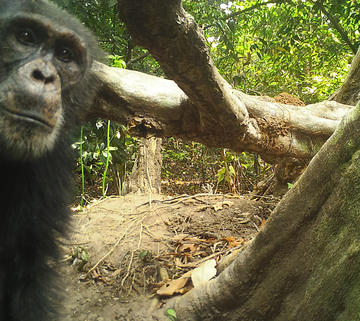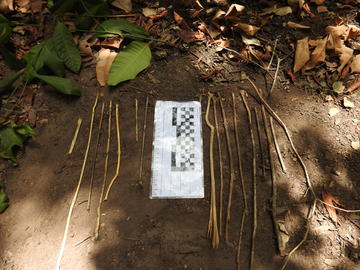
An adult male chimpanzee inspects a camera trap next to a bee hive
New research from the University of Oxford, published today in Royal Society Open Science reveals new chimpanzee behaviours and behavioural variation between neighbouring communities in Guinea-Bissau, contributing to our understanding of chimpanzee culture.
Animal culture consists of behaviours that are specific to different groups, and are transmitted and maintained across generations by learning from others. Culture has now been confirmed in many animal species, including humpback whales, song birds, and chimpanzees. Culture can be a source of adaptations, since individuals can more easily discover the solution to a problem if they pay attention to or copy the behaviour of other individuals. Therefore, culture can help animals better exploit their natural and social environment. Few studies have compared neighbouring groups of chimpanzees, especially those living in habitats fragmented by human activity, even though their culture is in imminent danger of disappearing due to human pressure and habitat destruction.

Tools used by chimpanzees to dip for honey
Joana Bessa, a DPhil student at the Department of Biology, travelled to Cantanhez National Park in south-west Guinea-Bissau. There are around 110 small villages in the park, with at least ten distinct communities of chimpanzees. Chimpanzees and humans live close together and share some of the same wild and cultivated food resources.
Over a period of two years, and in collaboration with an amazing team of local field assistants (Mamadú Cassamá, Dula Camara, Iaia Camara, Djibi Indjai, Idrissa Galiza, and Fernando N’Dafá) and Guinea-Bissau’s Institute for Biodiversity and Protected Areas (IBAP), she investigated the behaviour of chimpanzees in four neighbouring communities. The team collected data by walking in the forest and covering more than 1000km, as well as setting up 56 camera traps that recorded over 4000 chimpanzee videos. They also analysed chimpanzee faeces, discarded foods, nests, and tools used by chimpanzees.
Using the data collected, Joana made a list of 22 chimpanzee behaviours. Some of these behaviours have been confirmed in all known chimpanzee communities across Africa, but most had never been confirmed in Cantanhez or in Guinea-Bissau. For example, Cantanhez chimpanzees use tools to dip for honey in bee’s nests, carry out leaf clipping, and make ‘raspberry vocalisations’, a rare behaviour in the wild.
Most excitingly, some of the behaviours have never been observed before, such as chimpanzees eating salty mangrove leaves.
“By studying animal culture, researchers can better understand the different ways animals adapt to their environment (like foraging techniques, migratory patterns, and communication of information), which can be a valuable tool for conservation”
Joana Bessa
This research highlights how the study of neighbouring communities, as well as the study of previously neglected communities living in anthropogenic landscapes, can be important in the study of animal culture. Joana is next planning to take a closer look at some of the behaviours found, and see if and how the shared behaviours vary between communities. She also aims to understand the function of some of the rarer or newer behaviours – such as eating salty mangrove leaves.
“The rate of habitat destruction and climate change that wild species are currently facing means that there has never been a more relevant time to study how different animal communities behave and adapt to their changing environments in order to survive.”
Joana Bessa
To read more about this research, published in Royal Society Open Science, please visit: https://royalsocietypublishing.org/doi/10.1098/rsos.211518